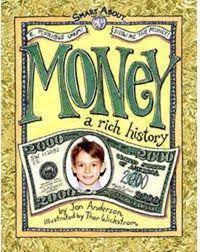Money Cent$
Listen to the Recess! Clip
| Author | John Cech |
| Air Date | 4/22/2004 |

Money Cent$ Transcript
It’s National Teach Your Children to Save Day, and in today’s market, that means moving to a much higher level than the traditional piggy bank. We adults know that we’re not saving enough, or investing as shrewdly as we should, or budgeting with rigorous discipline. In our consumer culture, of course, we are supposed to spend: and children are, too. But just as we seek to be enlightened consumers, and savers, so kids can also benefit from having good research, so that they, too, can hang onto more of their allowances and chores earnings. To help raise some consciousness and some basic questions, here are two from a number of recent books for kids about the color and the nature of money.
Jon Anderson’s Money, a Rich History, with illustrations by Thor Wickstrom provides a good jumping-off point for younger grade school children into the general subject of where those things called coins and bills come from: ancient Lydia (that is to say, present day Turkey) in the case of the former, and ancient China and 17th century Sweden in the case of paper currency. Told with cartoon-like illustrations, this a lively excursion through some essential concepts and economic principles, like money as a medium of exchange, or the ancient systems of barter and “trading” –remember all those deals that got struck on the playground? There’s also some fascinating money lore, like the word, “salary,” that refers to the salt that was paid to the Roman legionnaires as their wages. This gives new meaning to the expression, to “salt it away.”
If your children’s interest levels on this subject are piquing, you might want to send them to The Kids Guide to Money Cent$ by Keltie Thomas, with pictures by Stephen MacEachern. The approach here is that of the hypothetical, case-study model. The book follows the experiences of three middle-schoolers — Alicia, Dan, and Jeff as they sort out things like why Dan always seems to have a low cash flow. A very important section of the book is devoted to assessing the worth of something and the budgeting discipline that it takes to reach the goal, say, of a new BMX bike or skate gear or sneakers. For the kids, part of their analysis has to do with deciding how much they’re willing to pay for the prestige of wearing certain designer logos.
There’s also vital information about getting scammed, making sound investments, using credit cards, and launching one’s own business trajectory — like the real-life Matthew Balick and Justin Lewis did in 1997, when they were eight-years-old and invented a toy that lead to their founding a company, 2 Bored Boys. This is a relaxed, smart, kid-friendly approach to the larger world of money — one which values the process of learning and wouldn’t dream of telling you, “You’re fired.”